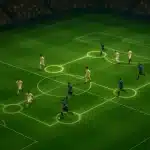Introduction to the Soccer Offside Rule
Hey there, fellow soccer ball lover! If you’ve ever found yourself scratching your head when an offside flag goes up, you’re not alone. The soccer offside rule is one of the most talked-about and sometimes misunderstood elements of the beautiful game. As someone who lives and breathes soccer, I’m excited to walk you through everything you need to know to truly grasp this vital part of soccer. From the basics explaining what the rule is, to the strategic impact it has on gameplay, and even how new technology affects offside decisions, we’ll cover it all. Whether you’re a beginner trying to understand why a goal was disallowed or a seasoned fan wanting to deepen your knowledge, this guide is tailor-made for you.
In this article, we’ll explore the exact criteria for an offside position, key exceptions, the role of officials (including assistants and VAR technology), and common misconceptions. Plus, we’ll look at how different leagues interpret the rule and how offense and defense use it strategically. So buckle up, because by the end, you’ll be well-versed in the soccer offside rule and ready to impress your friends during the next match!
What Is the Offside Rule?
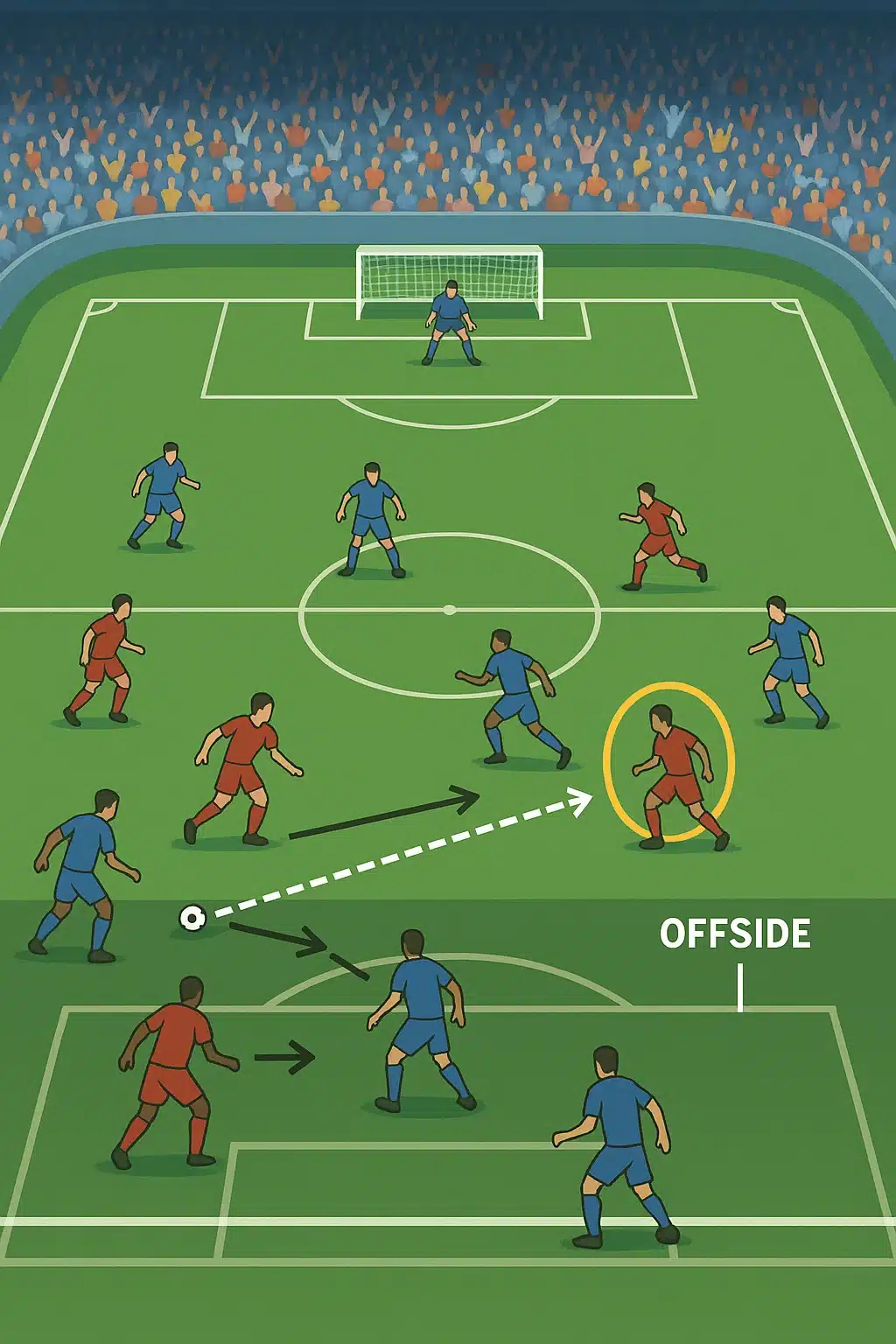
To kick things off, let’s define the soccer offside rule. Simply put, a player is offside if, at the very moment their teammate passes the ball to them, they are closer to the opponent’s goal line than both the ball and the second-last defender (usually the last outfield player). This position gives the player an unfair advantage, as they are “goal-hanging” — waiting where it’s easier to score.
However, being in an offside position itself is not an offense. A player is penalized only when they become actively involved in play by receiving the ball or interfering with opponents while in that position. This distinction is critical and often causes confusion among fans and players alike.
Why the Rule Exists: Purpose and Fair Play
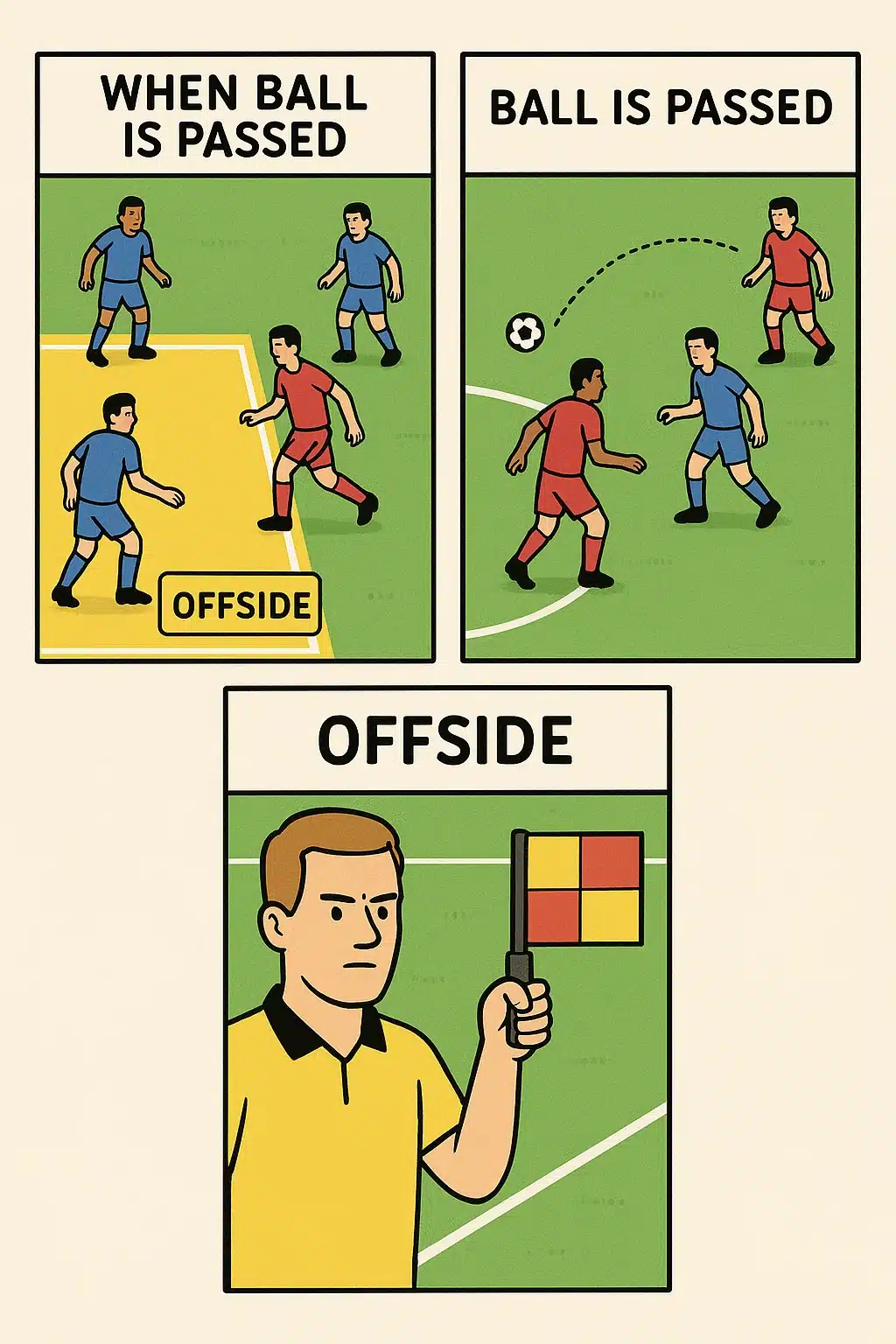
Why enforce such a rule? Well, offside is all about maintaining fairness and encouraging skillful play. Without this regulation, attackers could simply stand close to the goalkeeper, waiting for a long pass to score an easy goal — not very exciting or challenging! The offside rule forces players to time their runs perfectly and maintain good positioning. It rewards teamwork, anticipating passes, and tactical play.
In essence, the offside rule helps keep the game flowing and tactically stimulating. It encourages defensive lines to hold their shape and attackers to be clever with their movements, making soccer a compelling sport to watch and play.
Understanding the Offside Position
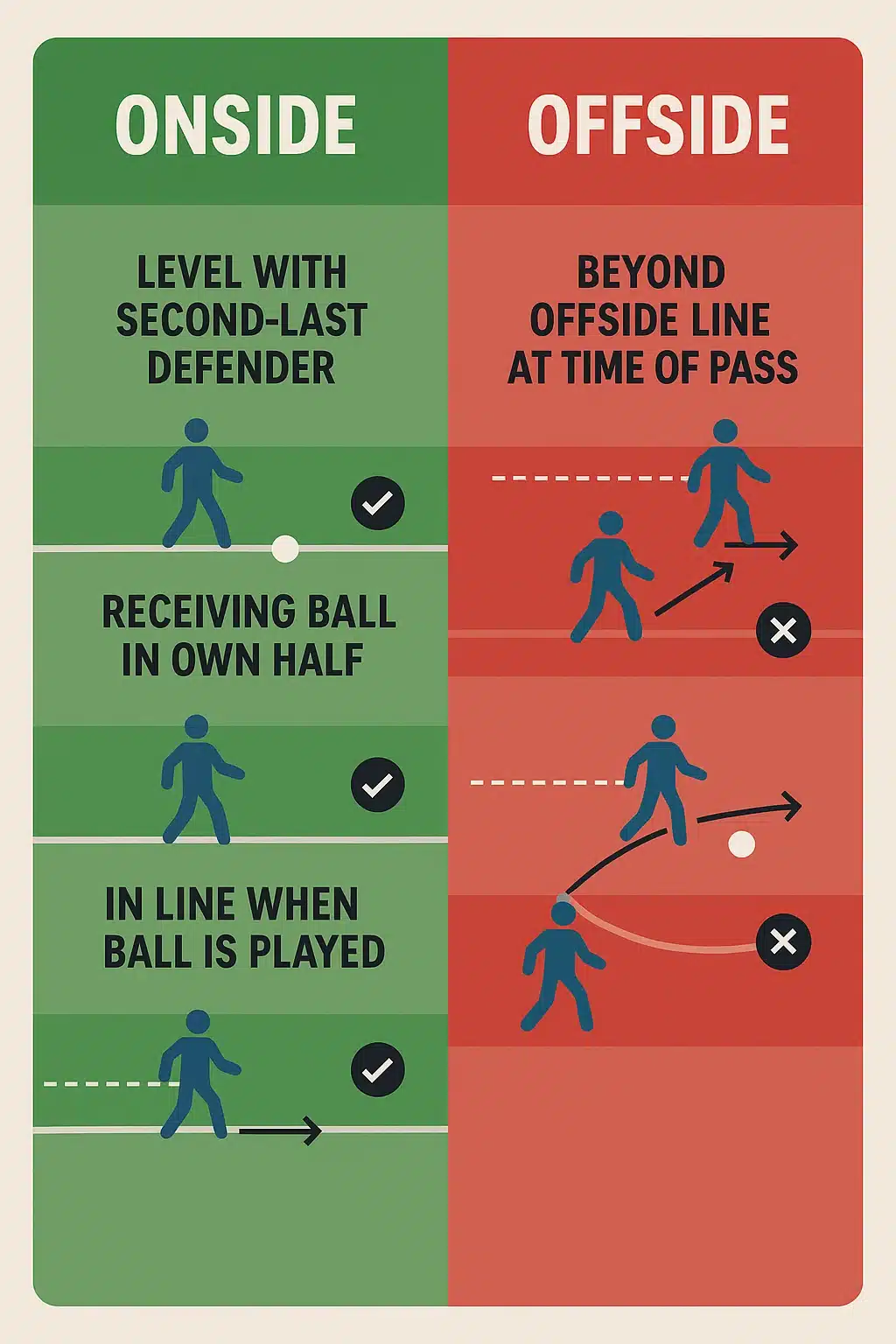
Criteria Defining Offside Position
Here’s how you can tell if a player is offside:
- Position relative to defenders: The player must be nearer the opponent’s goal line than the second-last defender.
- Timing of the pass: The player’s position is judged at the exact moment the ball is played.
- Half of the field: The player must be in the opponent’s half of the field.
Remember, it’s about where the player is when the ball is passed, not where they receive it.
Active Play Involvement: When Offside Becomes an Offense
Being offside is not a foul in itself but becomes an offense when the player in that position actively engages with the play. This happens mainly in several scenarios:
Receiving the Ball and Gaining Advantage
Imagine a striker darts beyond the defenders in an offside position and receives a direct pass from a teammate. This play stops immediately because they used their position to gain a significant advantage.
Interfering with Opponents and Play
Even if they don’t receive the ball, if an offside player distracts or obstructs defenders or blocks the goalkeeper’s line of sight — thus affecting the opponents’ ability to play — the referee can call offside.
Key Exceptions to the Offside Rule
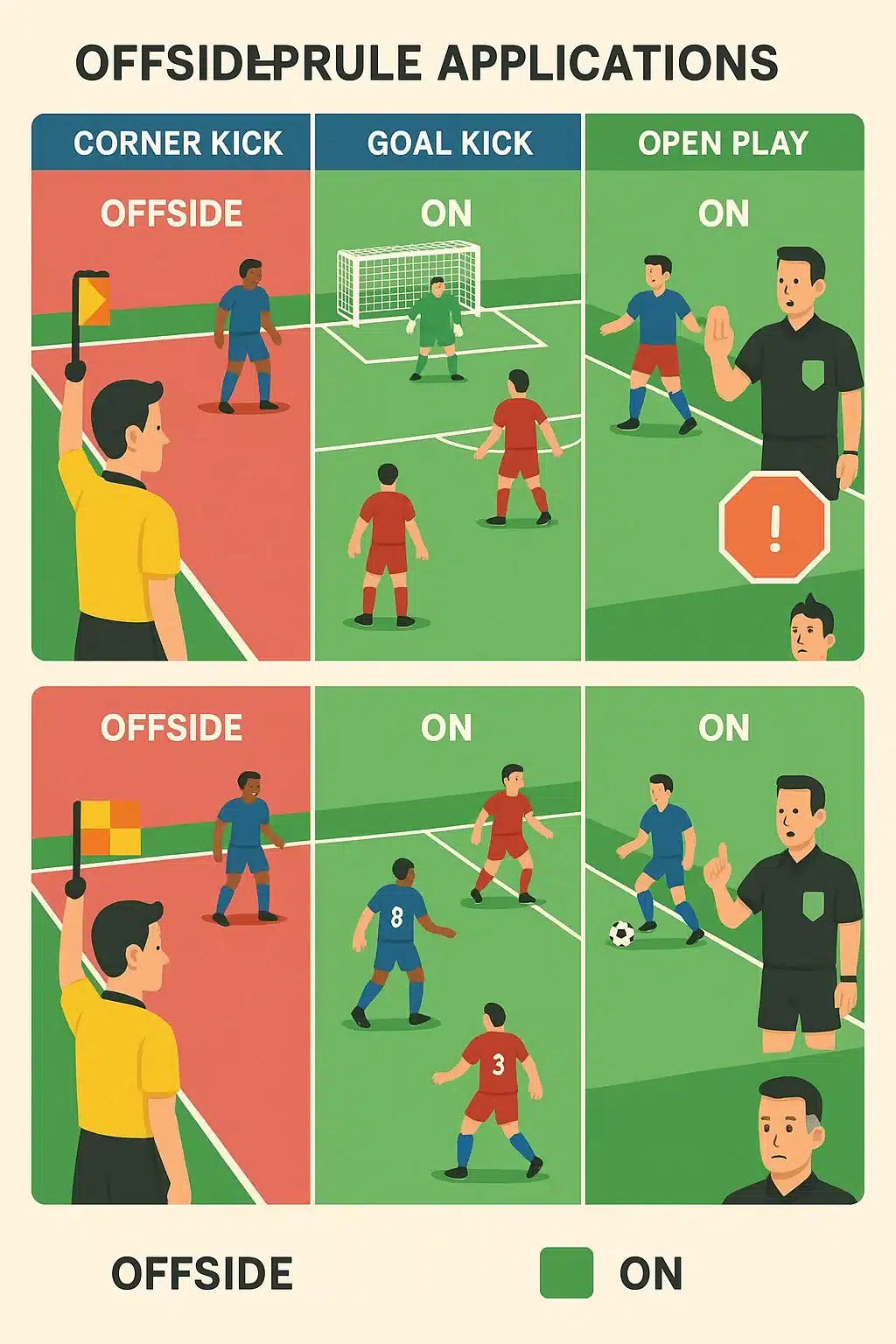
Believe it or not, not every forward play near the goal is offside. There are vital exceptions to remember:
Offside Exemptions: Goal Kicks, Throw-Ins, and Corner Kicks
When the attacking team restarts play with a:
- Goal kick
- Throw-in
- Corner kick
no offside offense can occur in these instances, regardless of player positioning. This gives attackers a chance to strategically maneuver without the usual offside constraints.
Specific Scenarios Where Offside Does Not Apply
Also, if a player receives the ball directly from a drop ball or kick-off, the offside rule does not apply.
Differences Between College Soccer and Professional Leagues
In college soccer (especially NCAA games), subtle differences exist, such as the way referees interpret ‘active involvement.’ They sometimes show a bit more leniency in calls compared to professional leagues governed by FIFA rules. For example, the offside rule’s application may be stricter in professional matches due to the higher stakes and experience levels of players and officials.
The Role of Officials in Enforcing the Offside Rule

Assistant Referees and Their Responsibilities
Assistant referees, often called linesmen, have the challenging job of spotting offside infractions in real time. Positioned along the sideline, they monitor player positions during passes and raise a flag when someone is offside.
Their decisions require sharp observation and split-second judgments, factoring in player positions, timing, and involvement.
Use of Video Assistant Referee (VAR) Technology
Technology has stepped into the game to decrease human errors. The Video Assistant Referee (VAR) reviews offside decisions using frame-by-frame analysis and advanced graphics showing player alignment.
Impact of VAR on Offside Decisions and Controversies
VAR has significantly improved accuracy but also sparked debates. Sometimes goals stand or get disallowed on extremely tight calls, with margins reduced to millimeters. Although VAR’s introduction has reduced blatant errors, soccer fans still discuss how it affects the game’s flow and spirit.
Offside Rule’s Strategic Influence on Soccer Tactics
How Defenders Use the Offside Trap
Defenders cleverly manipulate the offside rule through the offside trap — a coordinated move where defenders step up together just before a pass goes out, catching attackers offside. This tactic forces attackers to be cautious and enhances the defensive side’s control.
Offensive Strategies to Exploit the Rule
Attackers counteract traps by:
- Timing runs perfectly
- Staying in line with defenders as passes are played
- Using diagonal runs to confuse the defensive line
Player Positioning and Timing Runs
Teams drill precise positioning and timing using video analysis and coaching. Players train to maximize legality and steal that milliseconds’ advantage crucial for scoring.
Common Misconceptions and Clarifications
Misunderstood Aspects of Offside Position and Offense
One widely misinterpreted fact is that a player cannot be offside directly from their own half, and that being behind the ball is never offside — even if near the opponent’s goal.
When Being in Offside Position Is Not a Foul
If a player is in an offside position but:
- Does not interact with play or opponents
- Remains passive
no call is made.
Historical Evolution of the Soccer Offside Rule
Changes from Early Versions to Modern Interpretations
The offside rule has evolved from a strict “three defenders” requirement in soccer’s early days to the current “two defenders” standard, making the game faster and fairer.
Influence of Rule Changes on Game Dynamics
These changes encouraged more attacking play, less congestion near the goal, and a higher goal-scoring rate, enhancing soccer’s entertainment value globally.
Offside Rule Variations Across Different Soccer Organizations
Differences in NCAA, FIFA, and Other Associations
Besides NCAA leniency, local amateur and youth leagues may adapt offside rules for educational purposes — allowing younger players to focus on development and enjoyment.
How Women’s Soccer Applies the Offside Rule
Women’s soccer follows the same offside rules as men’s under FIFA, ensuring fairness and consistency in all professional competitions worldwide.
Practical Application: Step-by-Step Guide to Offside Decisions
Recognizing Offside in Real-Time Play
To judge offside, officials:
- Observe player position when pass is played
- Identify second-last defender
- Watch for active involvement in play
Referee Signals and Communication for Offside Calls
Assistants raise the flag straight up to signal offside. Referees then blow the whistle to stop play, awarding an indirect free kick to the opposing team at the place of the offense.
Offside Rule Impact on Game Flow and Stoppage Time
How Offside Calls Affect Momentum and Player Psychology
Frequent offside calls can halt attacking momentum, frustrating attackers but boosting defenders’ morale.
Managing Stoppages to Maintain Fair Play
Referees must balance enforcing the law and keeping the game dynamic, minimizing unnecessary delays.
Unique International Perspectives on the Offside Rule
Cultural Views and Commentary on Offside Enforcement
In some countries, fans embrace offside calls as part of tactical chess; in others, controversial decisions spark passionate disputes and debates.
Notable Controversies and Lessons Learned
Historic matches have hinged on offside rulings — reminding us of the rule’s immense influence and importance for fairness.
FAQs
1. How does the soccer offside rule work in professional leagues?
In professional leagues, the offside is judged at the moment the ball is passed, with a player offside if any part of their head, body, or feet is closer to the opponent’s goal line than both the ball and second-last defender, unless exceptions apply.
2. What are the exceptions to the soccer offside rule explained?
Players cannot be offside directly from goal kicks, throw-ins, and corner kicks, meaning these restarts are exempt from offside infractions.
3. How does the offside rule in college soccer differ from professional soccer?
College soccer sometimes applies the rule with more leniency and different interpretations of “active involvement,” resulting in fewer offside calls compared to professional leagues.
4. How does VAR technology affect offside decisions in soccer?
VAR reviews close offside calls using slow-motion and virtual lines, increasing decision accuracy but sometimes leading to debates regarding marginal calls.
5. When is a player considered offside in soccer?
A player is considered offside when they are nearer the opponent’s goal line than both the ball and second-last defender at the passing moment, and they participate actively by receiving the ball or interfering with opponents.
Quick Takeaways/Key Points
- The soccer offside rule ensures fairness and encourages skillful attacking and defending.
- A player must be in the opponent’s half and ahead of both the ball and second-last defender at pass moment to possibly be offside.
- Being in an offside position is not a foul unless actively involved in play.
- Exceptions include no offside from goal kicks, throw-ins, and corner kicks.
- Assistant referees and VAR technology play vital roles in enforcing the rule accurately, though debates on tight calls continue.
- Teams use the offside trap as a key defensive tactic; attackers counter with smart positioning and timing.
- The rule has evolved historically to enhance game dynamics and fairness.
- College soccer and women’s soccer apply the offside rule similarly but differ slightly in interpretation and enforcement at times.
Conclusion
As a soccer lover, understanding the soccer offside rule deeply not only enhances your appreciation for the sport but also lets you enjoy and analyze matches more insightfully. This rule, while sometimes tricky and prone to debate, plays a pivotal role in balancing offensive adventures and defensive solidity — making the game thrilling from whistle to whistle. With ongoing advancements like VAR technology, we continue to see improvements in fair play enforcement without losing the spirit of the game.
Next time you watch your favorite team in action, try spotting those tight offside calls and observe how players and coaches adjust tactics around this fundamental rule. And remember, every offside decision is a piece of soccer’s rich strategic puzzle.
Stay curious, keep loving the game, and never hesitate to dive deeper into its rules — it makes watching even more rewarding!


